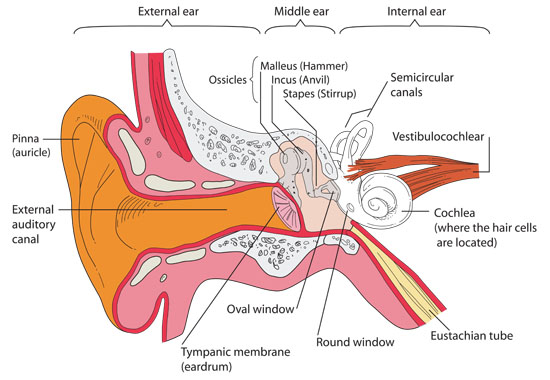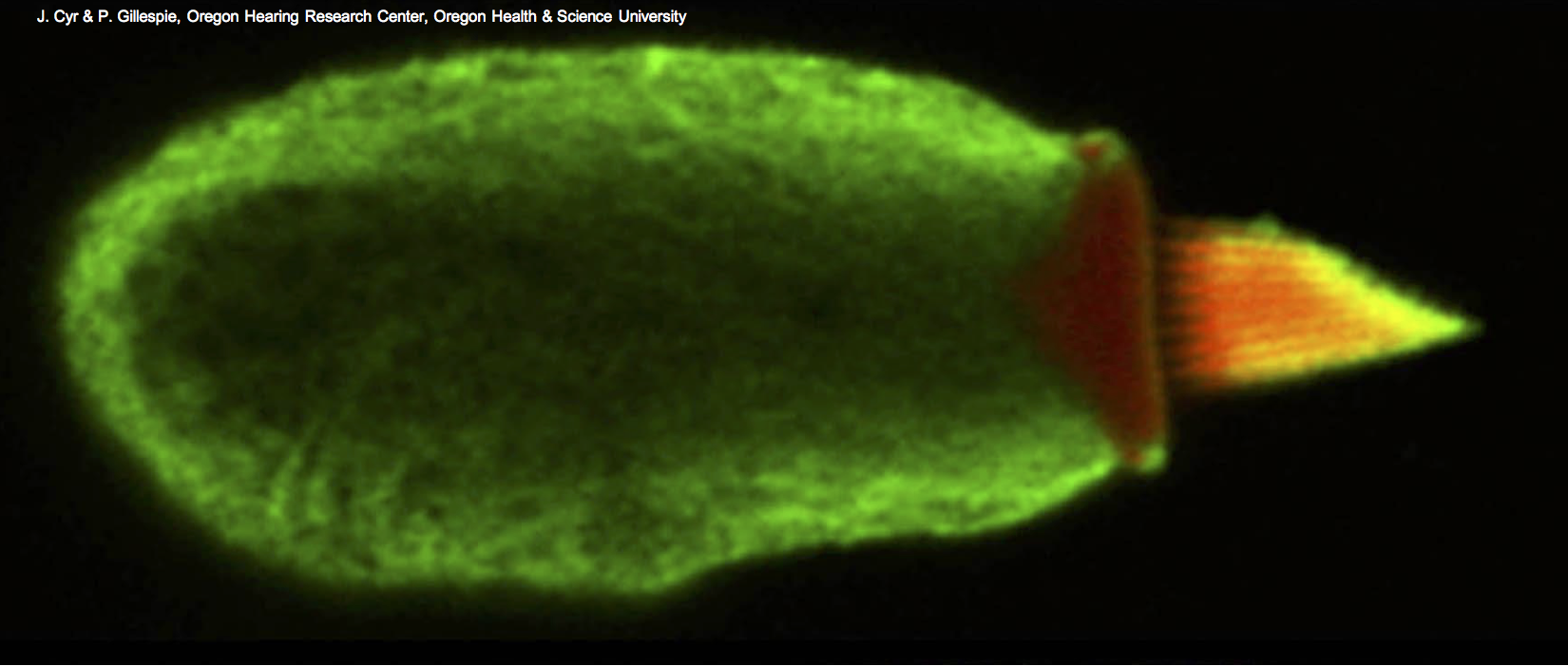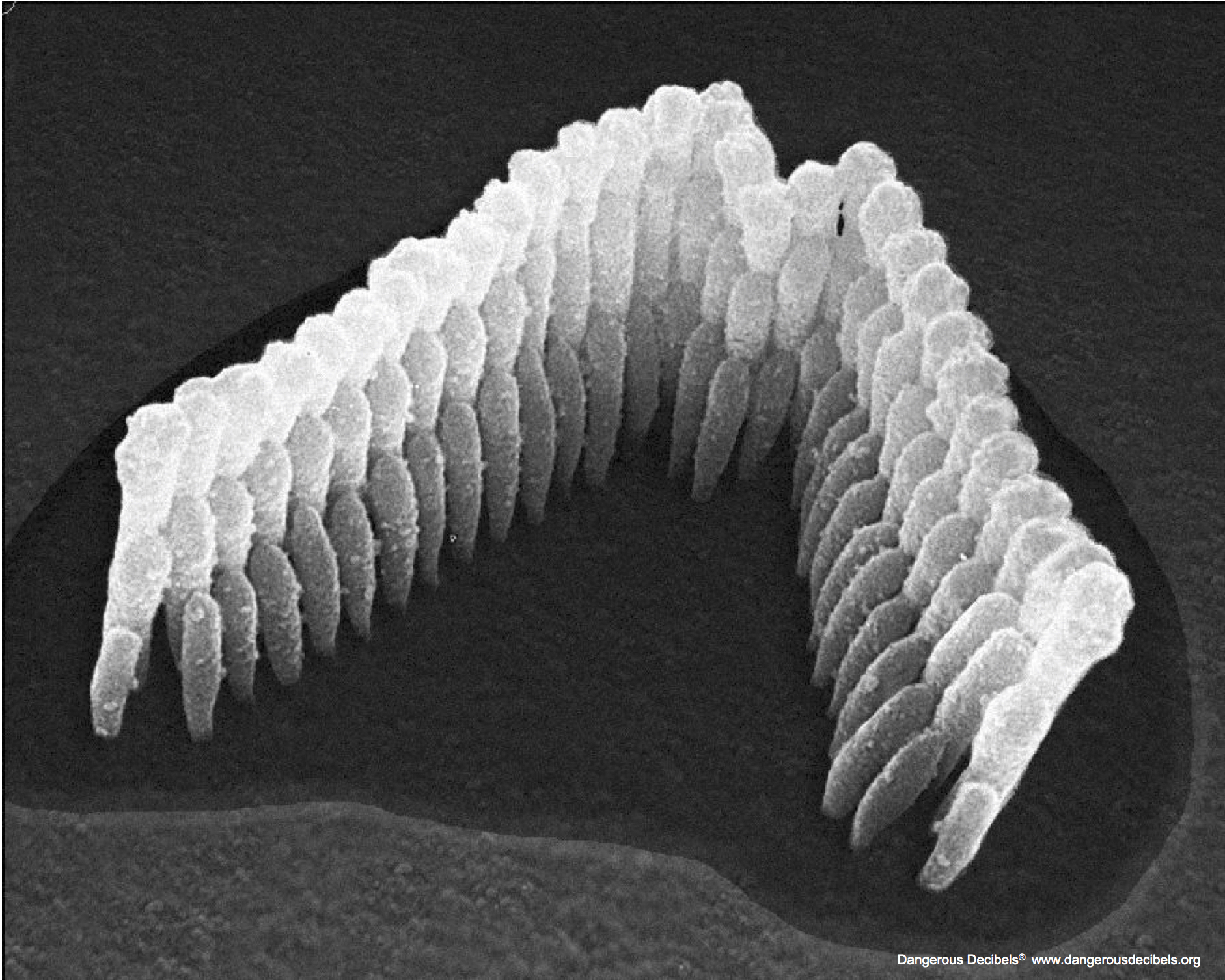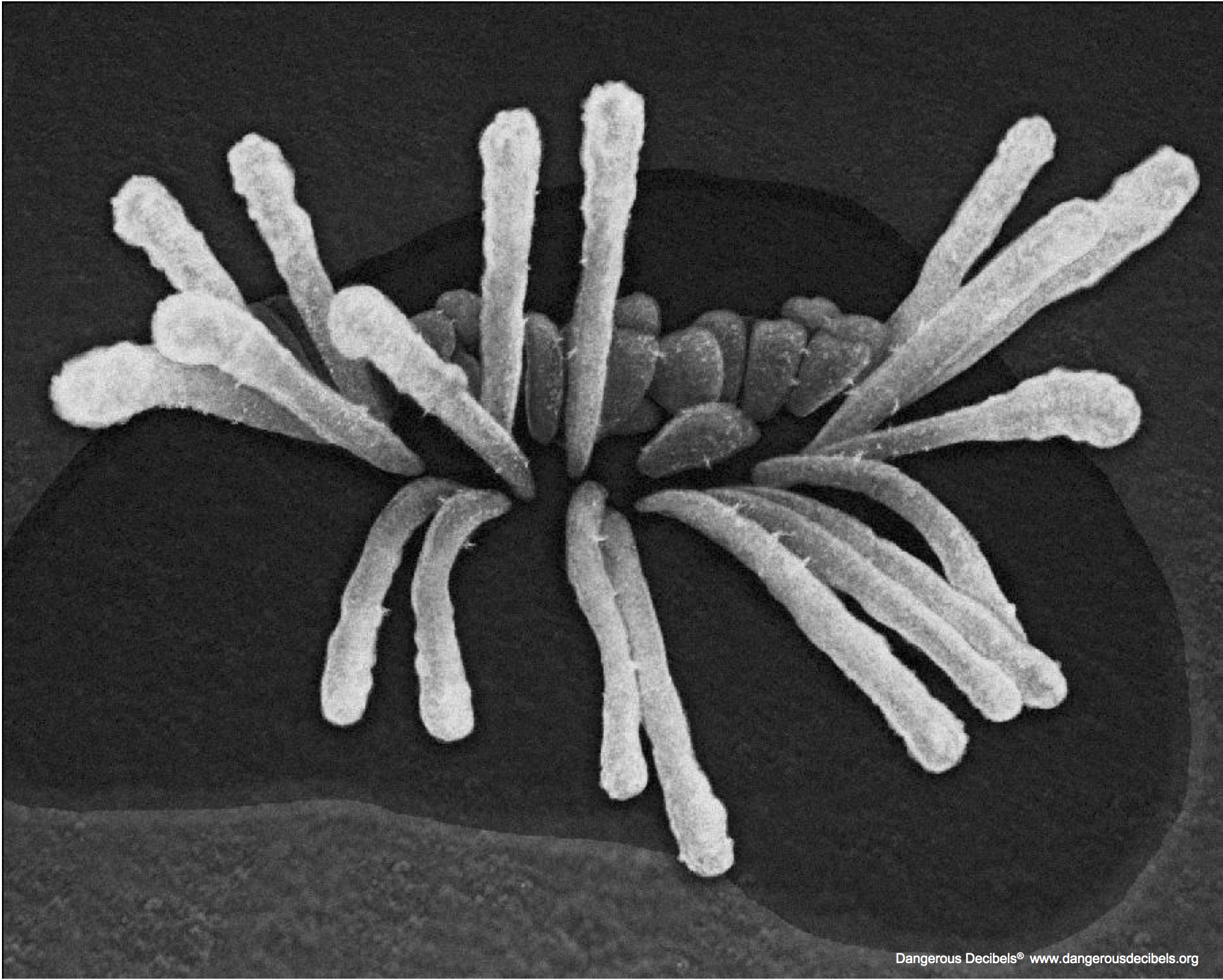Developed by W.K. Adams
Students explore how the ear hears and work through an interactive demonstration. These activities are included in the larger Sound and Music Lesson Plan.
Science Topics
Sound Waves
Vibrations
Sound
Sense of Hearing
Health
Energy
Process Skills
Observing
Predicting
Making models
Scientific inquiry
Comparing
Communicating
Grade Level
3-12
Preparation
30 minutes
Set-Up
5 minutes
Activity
30 minutes
Clean-Up
5 minutes
Learning Goals
Students will be able to:
- Demonstrate the path that sound vibrations follow through the ear
- Describe how ears can be permanently damaged by loud sounds.
Materials
4 Images of Ear
5 pipe cleaners per student (or just 5 for the educator)
Set-Up
Review the Explanation section below. You can also read the complete Sound and Music lesson.
Introduce the Activity
Students will sit quietly listening to the sounds around them. Then, they should share one or two sound they heard.
Tell the class that even though all these sounds seem very different, all sounds are caused by the same thing. Explain that they will learn how their ears hear those sounds.
Doing the Activity
Your Ear – see video
Show the large anatomy of the ear poster and ask if any of the students have learned about the ear before. Let students offer ideas for a minute or so to get them thinking about the ear.

How we hear
1. Ask the class what the outside of the ear is called: the pinna or auricle
→ Explain how sound vibrations are funneled into the ear by the pinna and then travel along the ear canal into the ear.
2. Point to the eardrum and ask what the pink part at the end of the ear canal is called.
→ Repeat again that vibrations are funneled into the ear canal by the pinna, travel along the canal into the ear drum and make the eardrum vibrate.
3. Ask the class what the three tiny bones are called: the ossicles made up of the malleus, the incus, and the stapes.
→ Repeat the route through the ear again, explain now how the eardrum vibrations then make the ossicle each vibrate one at a time. The eardrum vibrations make the malleus vibrate because it is attached to the eardrum. The malleus is attached to the incus, so it makes the incus vibrate and then the incus is attached to the stapes which vibrates. Finally, the stapes sends the vibrations into the snail shaped thing (point to the cochlea).
4. Ask the class what they think the snail shaped thing is called: the cochlea
→ The vibrations continue through the three tiny bones in your middle ear (the ossicles) to the cochlea. The cochlea is filled with thousands of tiny sensors like this: (hold up the hair cell picture next to the ear anatomy poster)

5. Ask the class what the hair cell poster looks like to them.
NOTE: It’s fun to ask the students to tell you what they think the hair cell looks like. You might “candle” or other suggestions. Our favorite is “flaming pickle!”
6. Then ask them if they know what it is called.
→ Tell the class it is a tiny sensor called a hair cell and that the cochlea is filled with them. The green part is the cell body and the yellow part is the hair bundle.
7. Then ask them if they know what it is called.
→ Tell the class it is a tiny sensor called a hair cell and that the cochlea is filled with them. The green part is the cell body and the yellow part is the hair bundle.
8. Hold up the healthy hair bundle poster.
→ Tell them this is what a healthy hair bundle looks like (the yellow part of the pickle). See how the hairs are standing straight up? But when you listen to loud sounds, you can actually damage them. It’s the hair bundle at the top that can be damaged when you listen to loud music or are around loud sounds for too long.

9. Show them the damaged hair bundle poster.
→ Explain that they are damaged hair cells. Point out how some of them are laying down and others are broken off.

10. Ask them: What could have caused this?
→ The loud sounds have bent and broken them.
Build a Model – see video and “Bend it Break it” lesson
1. Ask the class if anyone has ever build a model before. You should get all sorts of offers: model car, model of the solar system etc. Tell them “good, you know what a model is.”
2. Explain that the class is going to make a model.
3. Pass out about 5 pipe cleaners to each student and instruct them not to bend or mess with them yet!
4. Students will make a fist and hold it out.
→ Their fist represents the green (pickle) part of the hair cell, called the body.)
5. Students will then place their pipe cleaner is their fist.
→ The pipe cleaners are the hair bundle.
6. Ask the students if they have any guesses for what their arm is.
→ The arm is the nerve taking the signal from the hair cells to the brain!
7. Now tell the following story to the class:
“You’re sitting at the table talking to your parents.”
Demonstrate how to gently brush their hands back and forth over the pipe cleaners as your dad talks to you in a normal conversational voice.
“Dad says we’re going to the fireworks show today. We get to sit in the (insert your stadium name here) stadium – the best seats there are! But if you want to go, you have to mow the lawn first.”
Ask: Do you think a lawn mower is kind of loud?
→ After students guess, tell them a typical push mower is actually a safe sound for up to two hours.
Ask: Is your yard save?
→ It depends on how big your yard is!
“So we’re going to go out to the yard and start the mower. It’s going to get a little louder.”
Brush the hair cells a little harder (not too hard so that they bend).
“Now we get to go to the (insert local name here) stadium.”
Ask: How loud are fireworks if you get really, really close?
“We’re pretty excited and then they start! Boom! Bang! Boom!”
Now have the students hit their hair bundles hard as their hands go past.
8. Ask the students what the hair bundles look like after the loud noise.
9. Ask the students to try and fix them (straighten them back out).
→ This is what happens in our ears. These are nerve cells and we can’t just regrow them. (unless you’re a bird or a frog.)
Back to your Ear
1. Go to the website http://www.noiseaddicts.com/2009/03/can-you-hear-this-hearing-test and play each sounds from 20 Hz to 20,000 Hz.
2. Students will raise their hands when they hear a sound.
NOTE: Students enjoy hearing the high sound and seeing what they are able to hear, and love to see that they can hear high sounds better than their teacher! (or any other adults in the room).
3. Explain that not everyone’s ears are the same; some are more sensitive, so if you can’t hear the 18,000 Hz sound, even when you’re young, it doesn’t have to be from damage. Most adults can’t hear higher than 12-15,000 Hz.
NOTE: use the words “low pitch” and “high pitch”
Explanation
We used Science of Sound, 3rd Ed. by Rossing, Moore and Wheeler as a reference.
Sound is used to describe two different things:
1. An auditory sensation in the ear;
2. The disturbance in a medium that can cause this sensation.
By making this distinction, the age-old question, “if a tree falls in a forest and no one is there to hear it, does it make a sound?” can be answered.
→ The outside of the ear is called the pinna. It collects the sound and funnels that sound into the ear. Sound waves travel through the air, reach the pinna, and are funneled down to the eardrum.
→ Sound waves hit the eardrum and cause it to vibrate.
→ The three tiny bones are the ossicles: the Malleus, the Incus, and the Stapes (stape-ees). That’s Latin for hammer, anvil, and stirrup. The bones are named for their shapes. The vibrations continue through the tree tiny bones in your middle ear (the ossicles)
Different parts of the cochlea have different resonant frequencies so are sensitive to different pitches. The hairs in the front of the cochlea sense high sounds and the hairs towards the back are sensitive to lower sounds. (This is partly due to the tension of the basilar membrane in different parts of the cochlea.) The hair cells in the front typically get damaged first since they are closer to the sound. This means when you have hearing damage, the is messed up, not just quieter.
→ Sound is caused by vibrations
→ Sound carries energy
→ The vibrations travel through the ear canal, eardrum, ossicles (3 tiny bones) and then into the cochlea
→ Different parts of the cochlea resonate with certain frequencies
some like high pitches
some like low pitches
→ The hair cells sense the sound and send electrical signals to your brain
Key Lesson Terminology
Pinna – the visible part of the outer ear, also called the auricle- if you can wiggle your ears, the pinna is what you wiggle.
Ossicles – three bones found in the ears of all mammals. These bones are the smallest bones in a person’s body (together, they are about the size of your thumbnail) and they act like a system of levers.
Malleus – also called the hammer. The bone of the middle ear that is attached to the eardrum and the incus (anvil)
Incus – also called the anvil. The bone of the middle ear that is attached to the malleus (hammer) and the stapes (stirrup).
Stapes – also called the stirrup. The tiny both of the middle ear that is connected to a window (the oval window) in the cochlea.
Cochlea – the snail-shaped part of the inner ear which contains the organ of Corti, also known as the organ of hearing.
Hair cell – signals the auditory nerve
Vibrations – a shaking back and forth movement
Pitch – how high or low a tone sounds to a person; how you perceive the frequency of vibrations
Frequency (rate) – wiggles per second (moves back and forth)
Resonant or Natural frequency – the frequency at which an object likes to vibrate – only certain frequencies resonate any given object.
Optional Extensions
There is a game on the Dangerous Decibels virtual lab that lets you hear what different sounds would be like if you had hearing damage
Modifications
It’s important to tell students with modifications what they should be looking for ahead of time so they are more willing to stay engaged with the activity and understand what they’re getting out of the experience.
Hard of hearing students can feel vibrations through speakers by touching them, or by touching the instrument itself. With the straw instrument, they can feel the vibrations on their lips and their tongue.
